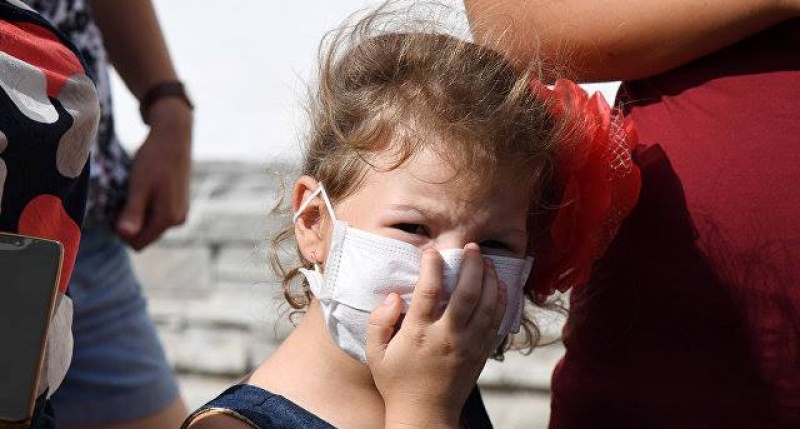Threats of prosecution to silence protest over new toxic emissions from Crimean Titanium factory

Amid mounting concern over new toxic emissions from the Crimean Titanium factory in Russian-occupied Armyansk, Kateryna Pyvovar called on other mothers to join her in at the city administration building to demand a meeting with its head, Vasily Telyzhenko. Within a few hours, police had turned up at her door, showed her a printout of her post on social media and issued her with a warning not to infringe Russian legislation by holding what they claimed was an ‘unauthorized protest’.
According to Pyvovar, the police officers, accompanied by a person from the prosecutor’s office, pulled no punches, saying “Stay at home. Why get yourself problems?”. She told them to prosecute her then and there as she did not plan to stay at home. The meeting with the Mayor did, in fact, take place, though it achieved nothing.
Pyvovar says that she has been depicted as a ‘Ukrainian provocateur’ in the media. According to Crimean activist Ilya Bolshedvorov, [Russian-controlled] Krym 24 is full of claims that Armyansk residents like Pyvovar, who posted residents of Armyansk are provocateurs from mainland Ukraine and panic mongers. Such media makes sure, however, not to show residents suffering from the chemical emissions.
Like after the toxic leakage during the night from 23-24 August, most information about the impact upon people’s lives and health has come from social media. As reported, it took the occupation authorities two weeks to even evacuate pre-school and schoolchildren, while still trying to avoid words like ‘evacuation’.
With children having been returned to the city, and the ‘Armyansk Day’ festivities, which had to be cancelled in September rescheduled for 12 October, it was clear that the occupation regime did not want to hear about new problems.
That reluctance to know and refusal to react cannot change the facts, and certainly a large number of people have taken to social media again, reporting the familiar acrid smell and same ominous symptoms from 9 October.
Pyvovar has four children and says that the youngest’s skin was covered in a rash by the morning of 10 October. She called an ambulance which took her to the hospital with the child. The doctor called it allergic dermatitis and advised her to leave the city with her children. Later that same day, however, she returned to the hospital with a second children, who had the same rash, as well as swelling around the eyes and a cough. This time she was told it was bronchitis. Pyvovar says that she is noticing both the swelling and the cough with all her children. She is convinced that her own cough and other symptoms over the past two months are solely linked with the emissions from the Crimean Titanium factory and says that others have also sought medical help for similar complaints. All are told that its bronchitis or sinusitis, which Pyvovar believes is because the city authorities are putting pressure on doctors to give diagnoses that don’t draw attention to the environmental problem that is the real cause.
She has decided for her family that they will leave the city since she does not expect the city ‘authorities’ to take any measures. This, she says, is what the doctors tell them: “If you want to help your children, leave the city”.
As reported, even after waiting two weeks, until 3-4 September, before evacuating children, it still took a second apparent release of toxic emissions before the occupation authorities finally announced on 14 September that a state of emergency was to be declared. Parents’ anxiety had been rising as the children were due back, however their return was delayed by a week.
Those in affected areas had reported a yellowish fog over the city and that things were covered in an oily slimy substance. From the rust appearing on metallic items, environmentalist Margarita Litvinenko suggested back on 28 August that it was likely that there had been a leak of sulphuric acid. Photos on social networks also showed the leaves of trees, etc. covered in a rust-like substance.
It is likely that the substance released, at least then, was a sulphur anhydride which, combined with water, can turn into sulphuric acid. The anhydride causes respiratory problems, irritation to the eyes and throat, allergic rashes and other reactions.
The release was probably caused by the retention basin near the plant drying up. This previously received water from the Dnipro River.
The Internet publication Primechania reported on 13 September that Armyansk residents were terrified and suffering physical effects, but were afraid to talk about them. “Crimeans are frightened of the press as they’re convinced that after the publications, problems may arise with the city administration and officials”.
People have told Primechania that the management of the Titanium factory and the local ‘authorities’ had been annoyed that residents had spoken with the publication. The latter reports that people were forced, whether in the form of advice, demands or downright ultimatums, not to speak to the press. The water supply stopped after annexation, with Russia refusing to repay debt for the pumping of water and to sign a new contract in which Crimea was identified as occupied territory.
Russia’s claim that Crimea was ‘always Russian’ can be refuted on historical grounds, but also conflicts with the number of practical reasons why Crimea always was and remains organically part of Ukraine. One such reason is that around 80 percent of the fresh water required for Crimean agriculture (and, it transpires, a major chemical factory) comes from mainland Ukraine.
See also Crimean Chemical Disaster will happen again while Ukraine helps oligarch Firtash bypass sanctions





